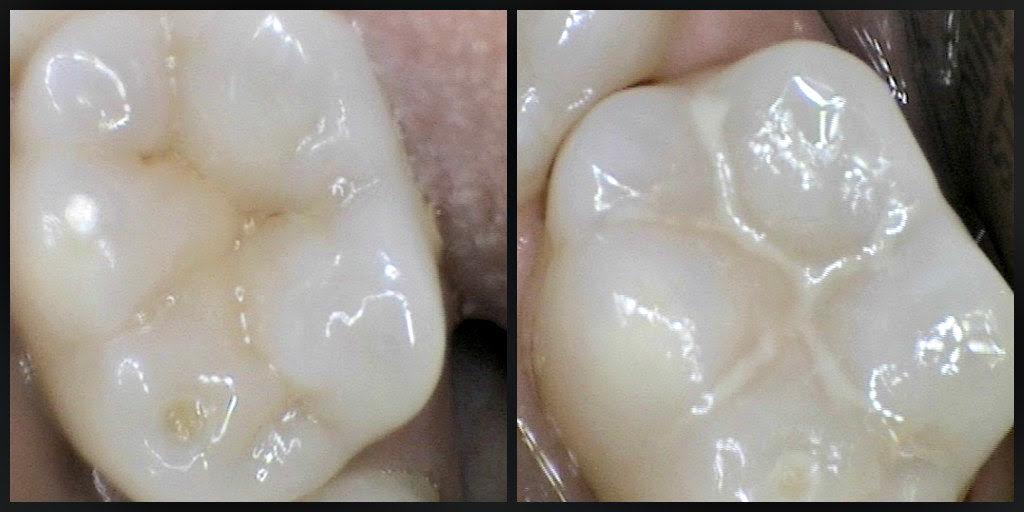Preventive Services
There are many innovations in the dental industry, reducing the risk of caries and gum disease with proper preventive services. These services include interceptive orthodontics, sealants, patient education and fluoridation. Our dental staff educates all patients on the risks and benefits of all treatment options.
Prevention and Sealants

Preventing tooth decay with sealants offers protection against the development of cavities for a healthy mouth. Plaque, a sticky film of bacteria, can develop on the teeth if they aren’t cleaned properly. If you don’t brush after eating, the plaque can use the sugar and starch from the food as energy, turning them into harmful acids that can wear away your enamel for more than 20 minutes. When this happens repeatedly, cavities will develop.
How Does Sealant Help?
The sealant is made from plastic and is applied to the chewing surfaces on the molars and premolars. The plastic resin bonds into depressions and grooves on the teeth, creating a barrier to protect the tooth from plaque and acids.
While brushing and flossing effectively remove the food particles and plaque from the smooth surfaces, your toothbrush isn’t likely to reach all the depressions and grooves. Sealants protect these areas to prevent cavities.
Is Application Easy?
The application process is quite simple and only takes a few minutes per tooth. First, the dentist will clean the teeth. The surface is then roughened using acid so the sealant has an appropriate surface to adhere to. The sealant is painted on and bonds to the tooth as it hardens. A curing light may be used.
As long as the sealant is intact, the tooth is protected from decay. Sealants can last up to several years under the force of normal chewing. Your dentist will check the condition of sealants and reapply it as required.
Are Sealants Just for Kids?
Cavities are common among children and teenagers, but they aren’t the only patients who can benefit from sealants.
Twice daily brushing with fluoride toothpaste is important to preventing tooth decay and keeping your mouth healthy. Floss and interdental cleaners, eating a balanced diet and limiting your snacking, along with regular visits to your dentist can keep you healthy. Talk to your dentist about the benefits of using sealants to prevent cavities.
Mouth Guards
Why Use Custom Mouth Guards?

The American Dental Association studies show more than 200,000 oral injuries have been prevented yearly with the use of mouth guards. However, the National Youth Sports Foundation estimates more than 5 million teeth each year. These injuries occur among children, high school and college athletes. Dental injuries are among the most common injuries sustained among athletes.
These injuries could be reduced or eliminated if individuals wore custom-made mouth guards. These dental devices can benefit those who participate in basketball, volleyball, baseball, football, soccer, rollerblading, softball, martial arts, skateboarding, martial arts, hockey, boxing, kickboxing and mountain biking.
Choose the Best Mouth Guards
You may find mouth guards at any sporting goods stores, but these are not the best quality. Dentist-fitted multi-laminated mouth guards are far superior to stock or boil and bite mouth guards. These inferior mouth guards don’t offer the perfect fit and aren’t worn as often due to discomfort and their interference with breathing and speaking abilities. They also don’t protect as well. Custom-fitted mouth guards may cost more, but they are well worth it.
Braces
What Is the Ideal Age for Braces?
Teeth can move out of position at any age. This means both children and adults can benefit from orthodontic treatments. Every child should receive a full evaluation before the age of seven to avoid longer treatment times required by many adults. Adults also often need additional treatment options.
What Causes These Problems?
Malocclusion, which means “bad bite,” can be caused by extra teeth, crowded teeth, missing teeth and misaligned jaws. These issues can be inherited or acquired. The most common reasons for acquired malocclusion include sucking a thumb or fingers for longer periods of time, early or late loss of teeth and accidents.
How Are Problems Corrected?
Pretreatment records are used by dentists to obtain an accurate diagnosis. This can include a review of medical and dental history, clinical examination, photos of your face and teeth, plaster models of your teeth and x-rays of the mouth and head. This will show your dentist the right treatments.
Your dentist will create a treatment plan just for your needs. This includes determining the best appliance and constructed it just for your mouth. There are a variety of options available. Once you begin treatment, you are in the active phase of treatment. This stage moves your teeth into the correct positions. The length of time for this treatment varies greatly, depending on the severity of the condition and the patient’s ability to follow instructions and cooperate.
Once the teeth are in the proper position, the retention phase begins. During this phase, the patient typically wears a retainer to keep the teeth in place. Surgery may be required for severe cases.
Are There Less Noticeable Options?
Overall, braces are far less noticeable than in the past. The brackets that hold the wires in place and are bonded to the front of the teeth can be metal or they may be clear or tooth colored. Wires are also made from space age materials to gently move the teeth into place. These wires are far less noticeable. Invisalign is also an invisible option for some patients.
How Long Will Treatment Take?
The average length of treatment is 24 months, but this can vary widely. Adults typically require longer treatment than children. The length of treatment can also vary based on the severity of the issue, how healthy the teeth and gums are and how well the patient follows instructions. Orthodontic treatment requires a time commitment but is worth the time.